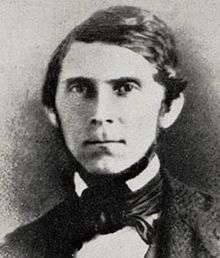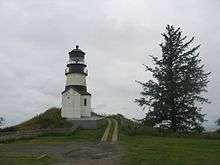William Pope McArthur
William Pope McArthur (April 2, 1814 – December 23, 1850) was an American naval officer and hydrologist who was involved in the first surveys of the Pacific Coast for the U.S. Coast and Geodetic Survey.
William Pope McArthur | |
|---|---|
 | |
| Born | April 2, 1814 Ste. Genevieve, Missouri |
| Died | December 23, 1850 At sea |
| Service/ | United States Navy |
| Years of service | 1832–1850 |
| Rank | Lieutenant commander |
| Unit | U.S. Coast and Geodetic Survey |
| Commands held | USS Consort US survey schooner Ewing |
| Battles/wars | Second Seminole War |
Early life
McArthur was born in Ste. Genevieve, Missouri to John and Mary (Linn) McArthur. McArthur's maternal uncle, Dr. Lewis F. Linn, was U.S. Senator for Missouri. At Linn's request, McArthur was appointed midshipman in the U.S. Navy on February 11, 1832. In 1837 he attended the Naval School at Norfolk, Virginia.
During the Second Seminole War (1837–1838), McArthur was promoted to the temporary rank of Lieutenant and placed in command of a small craft. Among the passengers was Joseph E. Johnston, who accompanied the vessel as a civilian topographical engineer. He later served as a general in the US Army and then the Confederate Army during the American Civil War.[1]
McArthur was wounded in both legs by Seminole at Jupiter, Florida. While one musket ball was pulled from one leg, a ball remained in the other leg. He was sent to the Naval Hospital in Norfolk, Virginia, for treatment and convalescence. There he met, courted, and married Mary Stone Young, the daughter of the Superintendent of the Hospital. Among their children was Lewis Linn McArthur, an Oregon Supreme Court Justice.
In 1840 he began a survey of the Gulf Of Mexico aboard the brig Consort.
Survey of the Pacific Coast

On October 27, 1848 A.D. Bache, Superintendent U.S. Coast Survey, instructed him to go to San Francisco, California to begin "the survey of the Western Coast of the United States."[1]
After sailing from New York McArthur was delayed in Panama by the influx of settlers in the California Gold Rush. In Panama, McArthur was asked to captain a former coal storage ship to San Francisco.[1] The von Humboldt left Panama on May 21, 1849 and took 102 days to arrive at San Francisco, the first 46 of which were spent getting to the Mexican port of Acapulco.[1] Among the four hundred passengers on von Humboldt were Collis P. Huntington, the future president of the Southern Pacific Railroad and San Francisco Society portrait painter Stephen W. Shaw.
In September 1849, Lieutenant Commander McArthur was placed in command of the US survey schooner Ewing which had been brought around the Cape Horn to the west coast by Lieutenant Washington Allon Bartlett.[2] Upon reaching San Francisco, The Ewing and the USS Massachusetts were hampered from progress in the survey due to desertions of their crews to the goldfields, including a mutiny when crew members rowing into the city from the Ewing threw an officer overboard in an attempt to desert to flee to the gold fields.[3] They managed to survey Mare Island Strait[2] before steaming to Hawaii to obtain crewmen from Hawaiian monarch King Kamehameha III.[1] They returned to San Francisco in the spring of 1850 with the coastal survey of northern California beginning on 1850-04-03 and continued up to the mouth of the Columbia River On August 1, 1850, while still in Oregon, McArthur purchased a 1/16 interest in Mare Island for $468.50[2] then returned to San Francisco later that month to prepare charts and write reports.
Cape Disappointment and Cape Flattery Lighthouses
In 1848 Congress had appropriated funds for two lighthouses in the act creating the Oregon Territory. McArthur was to recommend placing one at Cape Disappointment on the Columbia and one at Cape Flattery at the entrance to Puget Sound. In his report McArthur wrote:
The greatly increasing commerce of Oregon demands that these improvements be made immediately… Within the last eighteen months more vessels have crossed the Columbia river bar than had crossed it, perhaps, in all time past.[4]
Oregon Territory
McArthur and some of his ship mates were quite taken with Oregon and the Willamette Valley, he wrote:
The climate is agreeable and healthy. The water is not inferior to any in the world. The face of the country is too uneven to permit as general cultivation, still it will and must soon become a great agricultural and stock growing country. The scenery is beautiful and in some places and some points of view the grandest that the eye ever beheld.
Lieutenant Blunt who accompanied him on the expedition even made a land claim on behalf of himself, McArthur and Bartlett. McArthur's uncle, Senator Linn, along with Senator Thomas Hart Benton, had been an advocate of American expansion in the West.[1][5]
Death
McArthur was not to survive the voyage to the east coast in 1850. He became ill on board with dysentery, died, and was buried in Panama. The Navy purchased the original 956 acres (387 ha) of the Mare Island Naval Shipyard on January 4, 1853. McArthur's family share was $5,218.20.[2] in 1867, his body was disinterred and he was reburied on Mare Island.[1]
Ships and Placenames
McArthur's name is applied to several ships and placenames.
- McArthur, a schooner launched in 1876
- USC&GS McArthur, a survey ship in service in the United States Coast Survey from 1876 to 1878 and in the United States Coast and Geodetic Survey from 1878 to 1915
- SS William P. Mcarthur, a Liberty ship launched in 1942
- USC&GS McArthur (MSS 22), later NOAAS McArthur (S 330), a survey ship in service the United States Coast and Geodetic Survey from 1966 to 1970 and in the National Oceanic and Atmospheric Administration from 1970 to 2003, since 2006 a Blackwater vessel
- NOAAS McArthur II (R 330), an oceanographic research ship in service in the National Oceanic and Atmospheric Administration since 2003
- McArthur Peak (Alaska) – a 2,239-foot (682 m) mountain on Kuiu Island in Alaska
- McArthur Reef, a reef in the Sumner Strait off Clarence Strait in Alaska
References
- McArthur, Lewis Pacific Coast Survey of 1849 and 1850 Private history 1915 NOAA.gov retrieved December 26, 2007
- http://www.lib.noaa.gov/noaainfo/heritage/coastsurveyvol1/BACHE6.html
- Gudde, Dr. Erwin G. "Mutiny on the Ewing". Retrieved January 2, 2008. Originally published in The JOURNAL, Coast and Geodetic Survey, 1951-12-01, Number 4
- Hannable. William Historylink.org 2003-12-06 retrieved 2008-01-02
- Schwantes, Carlos Arnaldo The Pacific Northwest - An Interpretive History University of Nebraska Press 1989 1996 Rev. and enl. ed. p. 92 ISBN 0-8032-9228-7